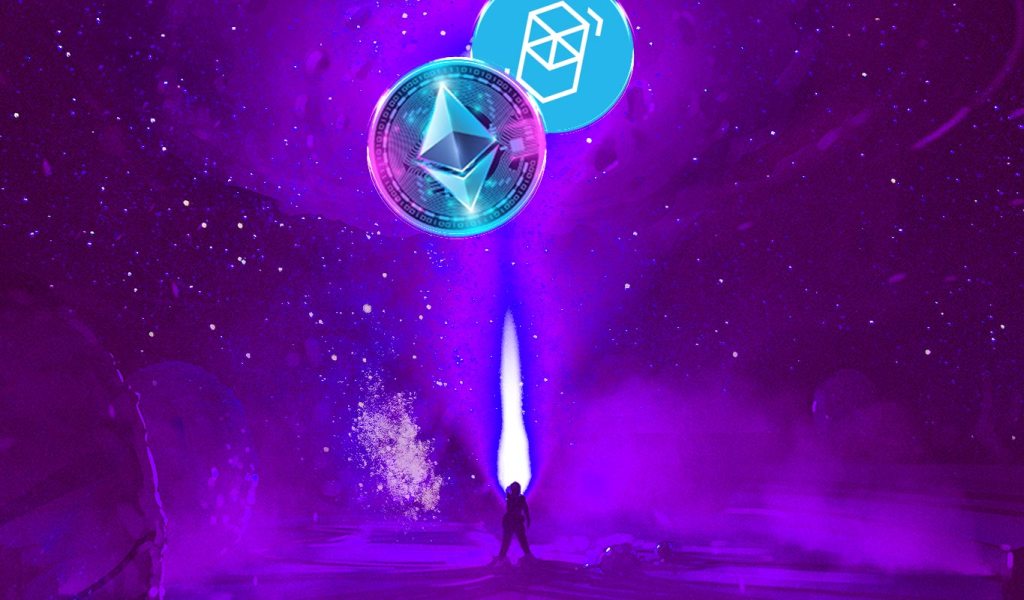
A closely followed crypto analyst believes one decentralized video-streaming altcoin project is about to go on a massive rally. Pseudonymous trader Kaleo tells his 632,300 followers on the social media platform X that Theta Network (THETA), a platform for decentralized video delivery, could soar by more than 200% as the social finance (SoFi) space finds […]
The post Crypto Trader Predicts Parabolic Rally for Decentralized Video Streaming Altcoin – Here’s His Target appeared first on The Daily Hodl.

The world’s largest crypto exchange platform by volume has announced support for memecoin Shiba Inu (SHIB) as a collateral asset for one of its loan programs. In a new company statement, Binance says that it’s adding SHIB, alongside a handful of other altcoins, as collateral to its flexible loan feature. Binance’s flexible loans allow users […]
The post Crypto Exchange Binance Announces Addition of Shiba Inu (SHIB) As Collateral Asset for Flexible Loans appeared first on The Daily Hodl.
 Sales of non-fungible tokens (NFTs) increased this week, with $179.64 million in sales over the last seven days. NFT sales rose 7.28% and transactions grew by 2.29% during this period, but the number of digital collectible buyers decreased by 4.34%. NFT Sales Improve This Week, Rising 7.28% Higher Sales of non-fungible tokens (NFTs) have trended […]
Sales of non-fungible tokens (NFTs) increased this week, with $179.64 million in sales over the last seven days. NFT sales rose 7.28% and transactions grew by 2.29% during this period, but the number of digital collectible buyers decreased by 4.34%. NFT Sales Improve This Week, Rising 7.28% Higher Sales of non-fungible tokens (NFTs) have trended […] Closing out the third week of January 2023, non-fungible token (NFT) assets saw a 16.39% increase in overall sales. 320,580 buyers participated in the NFT market action this past week, an increase of 43.48% compared to the week prior. $256.69 million in NFT sales were recorded over the last seven days, with $206.06 million being […]
Closing out the third week of January 2023, non-fungible token (NFT) assets saw a 16.39% increase in overall sales. 320,580 buyers participated in the NFT market action this past week, an increase of 43.48% compared to the week prior. $256.69 million in NFT sales were recorded over the last seven days, with $206.06 million being […] The first week of 2023 saw an upswing in non-fungible token (NFT) sales as seven-day volume increased 26.01% compared to the previous week, totaling approximately $208.99 million in NFT sales. Additionally, the top five NFT-issuing blockchains saw increases over the last week. Bored Ape NFT Collection Leads the Way with $19 Million in Sales, 52.82% […]
The first week of 2023 saw an upswing in non-fungible token (NFT) sales as seven-day volume increased 26.01% compared to the previous week, totaling approximately $208.99 million in NFT sales. Additionally, the top five NFT-issuing blockchains saw increases over the last week. Bored Ape NFT Collection Leads the Way with $19 Million in Sales, 52.82% […]
A popular analyst is digging into the charts to provide updated price targets for Ethereum (ETH) and a trio of crypto assets. Michaël van de Poppe first tells his 624,300 Twitter followers that Ethereum’s price keeps rising even as funding rates dry up in advance of the project’s mid-September transition from a proof-of-work (PoW) consensus […]
The post Top Crypto Strategist Predicts Rallies for Ethereum (ETH), Fantom (FTM) and Two Additional Altcoins appeared first on The Daily Hodl.

Market intelligence firm Santiment is naming four altcoins that are currently witnessing bullish sentiment based on an indicator that gauges the overall attitude of crypto traders and investors. Santiment says that the highest levels of positive sentiment are being enjoyed by XRP, Binance Coin (BNB), decentralized finance blockchain PancakeSwap (CAKE) and decentralized video platform Theta […]
The post XRP, Binance Coin (BNB) and Two Mid-Cap Altcoins Flashing Bullish in One Metric, Says Analytics Firm Santiment appeared first on The Daily Hodl.
 Theta network was trading at its highest point in three months on Friday, as prices broke out of a key resistance level. Today’s move comes as crypto markets were mostly higher in the session, climbing 2.86% as of writing. Near protocol rose by 17%, also recording multi-month highs. Theta Network (THETA) Theta network (THETA) was […]
Theta network was trading at its highest point in three months on Friday, as prices broke out of a key resistance level. Today’s move comes as crypto markets were mostly higher in the session, climbing 2.86% as of writing. Near protocol rose by 17%, also recording multi-month highs. Theta Network (THETA) Theta network (THETA) was […] THETA was trading higher on Tuesday, as prices rebounded, moving away from multi-year lows in the process. HNT also rallied, climbing by as much as 20% earlier in today’s session. Theta Network (THETA) THETA was one of the most notable movers during today’s session, as prices gained by nearly 20% earlier in the day. Following […]
THETA was trading higher on Tuesday, as prices rebounded, moving away from multi-year lows in the process. HNT also rallied, climbing by as much as 20% earlier in today’s session. Theta Network (THETA) THETA was one of the most notable movers during today’s session, as prices gained by nearly 20% earlier in the day. Following […]
An improving Tether discount in Asian markets and positive futures premiums for BTC and ETH suggest a slight recovery is in the making.
The total crypto market capitalization has been trading in a descending channel for the past 29 days and currently displays support at the $1.17 trillion level. In the past 7 days, Bitcoin (BTC) presented a modest 2% drop and Ether (ETH) faced a 5% correction.

The June 10 consumer price index (CPI) report showed an 8.6% year-on-year increase and crypto and stock markets immediately felt the impact, but it’s not certain whether the figure will convince the U.S. Federal Reserve to hesitate in future interest rate hikes.
The generalized bearish sentiment caused by weak macroeconomic data and uncertainties regarding the Federal Reserve's ability to curb inflation has severely impacted crypto markets.
The Fear and Greed Index hit 11/100 on June 9, and the data-driven sentiment gauge has been below 20 since May 8.

This persistent "extreme fear" reading indicates that investors are worried but, at the same time, it supposedly presents a buying opportunity.
Below are the winners and losers from the past seven days. While the two leading cryptocurrencies presented modest losses, a handful of mid-capitalization altcoins declined by 14% or more.

Helium’s (HNT) community approved the HIP-51 proposal, covering the economic and technical constructions required to support new users, devices and different types of networks, including cellular, VPN, and WiFi.
Chainlink (LINK) rallied 22% after the developers released a revamped Chainlink 2.0 roadmap, including native token staking.
Theta Token (THETA) gained 9.7% as the network announced livestream support using API technology which enabled instant and easy connection to apps and websites.
WAVES lost 28% after the $1,000 daily withdrawal limit for stablecoins in Vires Finance were implemented to avoid further pressure on the Neutrino Protocol Stablecoin (USDN).
The OKX Tether (USDT) premium is a good gauge of China-based retail crypto trader demand. It measures the difference between China-based peer-to-peer (P2P) trades and the United States dollar.
Excessive buying demand tends to pressure the indicator above fair value at 100%, and during bearish markets, Tether's market offer is flooded and causes a 4% or higher discount.

On May 31, the Tether price in Asian peer-to-peer markets entered a 4% discount, signaling intense retail selling pressure. Curiously, the situation improved on June 10 after the indicator moved to a 1.5% discount. Despite remaining negative, the metric shows investors' willingness to buy the dip as the total crypto capitalization dropped below $1.2 trillion.
To exclude externalities specific to the Tether instrument, traders must also analyze the cryptos futures markets. Perpetual contracts, also known as inverse swaps, have an embedded rate that is usually charged every eight hours. Exchanges use this fee to avoid exchange risk imbalances.
A positive funding rate indicates that longs (buyers) demand more leverage. However, the opposite situation occurs when shorts (sellers) require additional leverage, causing the funding rate to turn negative.

Perpetual contracts reflected mixed sentiment after Bitcoin and Ethereum held a slightly positive (bullish) funding rate, but altcoin rates were negative. For example, BNB’s negative 0.20% weekly rate equals 0.8% per month, which is generally not a concern for derivatives traders.
According to derivatives and trading indicators, investors are less inclined to reduce their positions at current levels, as shown by the modest improvement in the Tether premium.
The positive funding rate for Bitcoin and Ether futures displays traders' growing appetite for leveraged long positions as the total crypto capitalization broke below $1.2 trillion.
Unless the traditional markets and macroeconomic scenario deteriorates, there is reason to believe crypto investors are expecting a positive price move soon.
The views and opinions expressed here are solely those of the author and do not necessarily reflect the views of Cointelegraph. Every investment and trading move involves risk. You should conduct your own research when making a decision.